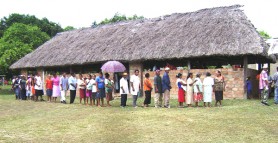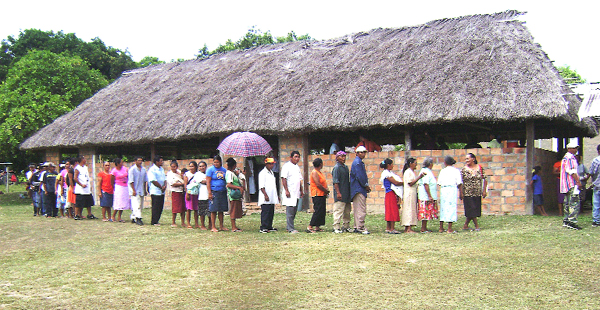The limited skills of residents of the South Rupununi was underscored as their representatives last week probed officials on the benefits from a proposed alluvial gold mining project to be undertaken by Romanex Guyana Exploration Limited in the Marudi Mountain.

Romanex is seeking to establish a large-scale alluvial gold mining operation at Marudi Mountain and last week Wednesday, the Environmental Protection Agency (EPA) held a public scoping meeting at the Aishalton community centre on the project. Stabroek News was present at the meeting. The meeting was part of the process towards the undertaking of an Environmental Impact Assessment (EIA), which will determine whether the EPA grants approval for the operation. A number of villagers from Aishalton and Karaudarnau, which are the villages closest to the site, participated in the meeting. Representatives from other surrounding communities were also present and the Deep South Rupununi residents raised issues of concern to them while also querying the benefits they could expect.
In relation to jobs, the need for capacity-building in the communities emerged as an issue as it was related that locals could not be employed in some jobs because they lack certain skills. Consultant to the EIA, Charles Ceres, pointed out that there is need for a capacity-building programme in the communities as they do not have the skills required. This is a necessity, he declared adding that it was an issue that subsisted not only in that area but in other parts of the country and requires a national response.
Meantime, residents said that they had limited information on the project with Aishalton councillor, Kid James chiding the team for the late sending of documents relating to the proposed operation. He asserted that many did not get the chance to study it. His contention was supported by fellow councillor, Tony James, who asked the assembled residents in their native Wapishana whether they understood what was happening and the response was a resounding no.
But the EPA officials including Geeta Singh and Romanex Country Director, Jennifer Falconer pointed out that there is still time for them to raise their concerns and they could do so in writing to the EPA. Additionally, interviews that would cover residents in the various villages and garner their views on the project began after the meeting ended.
During the meeting, residents acknowledged that mining had both negative and positive impacts and the need to minimize the negative was stressed. Toshao of Maruranau, Patrick Gomes said that most of the villages will be affected one way or the other. He stated that local persons should be trained to monitor the systems in place but the issue of capacity was raised here.
Earlier this year, Stabroek News had reported that Shoreham Resources Limited, a Canadian exploration company had exercised an option to acquire 75% of the shares of Romanex, which is held by Infinito Gold Corporation (formerly Vannessa Ventures Incorporated). A press release from Shoreham had also announced that the company had signed an agreement with a French mining company Rexma Participacions (Rexma), for that company to work in Shoreham’s Marudi Mountain Gold Project. The release had said that French gold mining company is looking to begin production at Marudi by November 1 and had committed to major expansion of production capacity within the next two years.
The track record of Rexma was raised with both the Jameses stating that they need to have more information about the company. Kid asserted that big mining companies change their names every two or three years. Falconer in response stated that Rexma will be operating under the auspices of Romanex and will be required to operate in a way in which Romanex has always done. She declared that Rexma has a reputation for environmentally-friendly mining.
History
On jobs, the residents were informed that 50 persons would be employed. Falconer said that the policy of the company is to take as many local workers as possible from the surrounding villages depending on their skill level. “We have a history of when we need labour, we come into the villages”, she asserted. The issue of scholarships in order to build capacity was also raised and Falconer pointed out that Romanex has a history of providing scholarships and they hope to build on this.
Earlier, Falconer had told residents that since March 2007, Romanex had been conducting exploration at Marudi and last year recognized that there was enough gold to commercialize operations. She declared that Romanex has a proven track record for environmentally safe mining and no chemicals will be used in the gold recovery process. “We bring employment, training…a market for goods and services”, she said adding there would be an improvement in the lives of residents.
Ceres, in outlining the approach to the EIA study stated that Rexma will be going to excavate the alluvial material close to the creek bed. He said that the pits will not be deeper than ten feet or three metres, a contention questioned by Tony.
Ceres noted that creeks will be diverted and work will start from downstream and work towards the “head” of the creek. This point had been raised by residents who said that they were concerned about what would happen to the waterways. When the mine is closed, the creeks will be restored to their original beds and reclamation will be done, Ceres said.
Alluvial mining has been deeply frowned upon by environmentalists and the government had over the years mulled a total ban on it because of the potential dangers to communities that depended on the creek water and the likely environmental damage.
Economic
opportunities
Ceres declared that the project is going to open economic opportunities for residents. He said that the road will open new areas to residents adding that the company will be involved in maintaining the road to Lethem.
But the consultant also said that there is a possibility of an increase in water-borne diseases as well as an increase in the cost of living.
Meantime, how the project fits into Guyana’s Low Carbon Development Strategy was also queried. “We’ve been asked to stop going into the forest…stop your slash and burn”, Tony stated. He declared that the meeting was a “show” and “regardless of what we say it will go on”, a point with which Ceres disagreed. But the councillor asserted that he is speaking from experience and it happens all the time.
The deep south Rupununi residents also grasped the opportunity to raise other issues of concern to them. The lack of information regarding other mining operations in the area was a general problem and a concern; they said adding that there needs to be more consultations. They raised the issue of fruitless attempts to have a meeting with medium-scale miners operating in the area. Another issue raised was miners transporting lumber out of the area. In this regard, a Guyana Geology and Mines Commission (GGMC) official said that the miners are given permission, when they cut down the trees to remove the logs. Additionally, the destruction of roads was a point raised.
Falconer, in responding, said that Romanex strives to consult and respects the wishes of surrounding communities. She said that they too have concerns about the medium-scale operators. She added that it is known that when moving heavy equipment, Romanex always fixes parts of the road.
A GGMC representative stated that the regulatory agency has in the last six weeks begun an environmental compliance campaign and went into Marudi recently to start an enforcement awareness campaign. He said that they have been urging miners to respect the villages they pass through.
The need to create partnerships was emphasized with Falconer noting that in terms of sourcing supplies-which was an issue raised, the company will buy what is available but the villages have to say what they can offer in terms of supply.
Creeks
The proposed mine is 155 kilometres (Km) from Lethem and 50 km from Aishalton. Karaudarnau, the closest community to the mine, is linked to the area by a trail and is 20.5km away. Several creeks flow through the project area and these are Locust, Pancake, Toucan2, Peace, Capadolla, Rice, Turtle, Sandra and Paunch Creeks. They will be mined.
According to the project summary, the project will entail the excavation of mineralized gravel, the establishment of a mineral processing plant for the recovery of gold and the construction of supporting facilities, buildings and road. No chemicals will be used and the project will serve as a demonstration of non-chemical recovery of gold from placer deposits.
It is expected that the mine will operate 10 hours each work day and will process 600 cubic metres of mineralized gravel each day. The equipment has been sized to operate for 350 days per year. Average production will be 200,000 cubic metres per year at the beginning of the operation and this will increase to 400,000 cubic metres annually in year two and this production level will be maintained for the remainder of the operation, the Summary states.
According to the project summary, preliminary works will consist of clearing the forested area for development into a surface mine. The forest will be cleared using conventional methods and chainsaws will be used for felling large trees. The timber will be used for construction purposes on site while any surplus will be stockpiled for future use. The summary states that cleared area will be limited to the area identified for ore recovery only. Barren zones within mineralized areas will not be cleared. This will result in small islands of vegetation within areas to be mined, thereby creating conditions for better regeneration of vegetation during reclamation, according to the summary.
As regards ore recovery, the alluvial deposit will be mined by open pit methods in the creeks’ flats. Gold will be recovered by gravity separation using mobile screen and concentrator units. This will allow rehabilitation of mined out areas to occur as work advances, the project summary states.
It said that before mining commences, the creek will be diverted, if necessary, by excavating a channel to connect points on the creek upstream and downstream of the mineralized zone. Pay dirt will be removed by an excavator working in the direction counter to flow in the creeks, that is, from downstream to upstream. Each mineralized zone will be excavated as several ponds consisting of bands. Excavation will only commence on another band after completion of the removal of pay dirt from the preceding band, according to the summary. Each pond will be surrounded by berm, approximately 3 metres high with a 4 metres wide crest.
The Summary states that to minimize impacts associated with discharge from the excavation operation, the gold recovery operation will function in a closed loop for water supply.
“Clear water supply, for gold recovery, will be obtained from the pond which was previously excavated. Water overflow from the previously excavated pond will be limited by the berm surrounding the pond.” It stated that after the completion of mining, the creek bed will be restored to its original depth and alignment and the diversion channel will be backfilled.
The company also plans to construct an all-weather gravel surfaced roadway, linking Marudi to Aishalton, about 45 kilometres long. The company also envisions maintaining the 180 kilometres long road from Lethem to Aishalton in the dry season by periodic grading to facilitate transportation of operating supplies into the mine site. The company also plans to build a 600-metre airstrip at the site. In April, Romanex and the GGMC had inked the licence for the company to mine at Marudi. Acting GGMC head, William Woolford had told this newspaper last year that Romanex was one of two companies granted licences for large-scale gold mining and was looking to produce between 50,000 to 100,000 ounces of gold per year.

